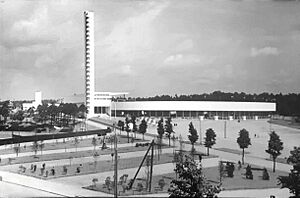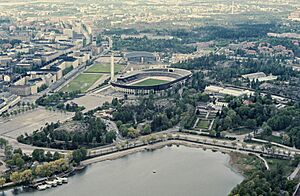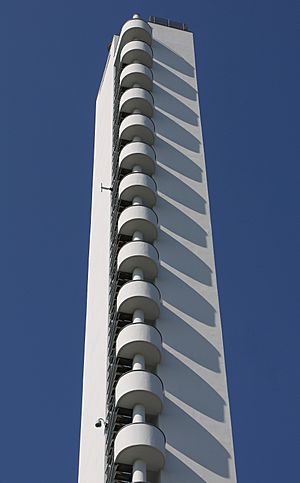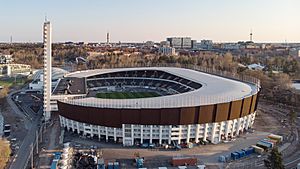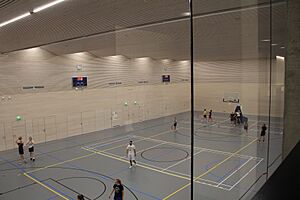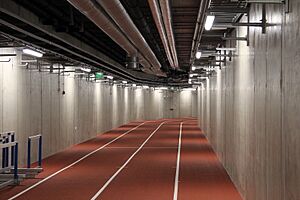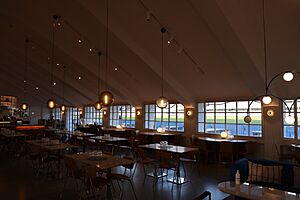Helsinki Olympic Stadium facts for kids
| Helsingin olympiastadion Helsingfors Olympiastadion |
|
|
"Stadikka"
|
|
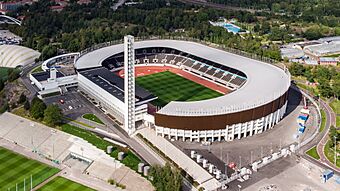
|
|
| Location | Helsinki, Finland |
|---|---|
| Coordinates | 60°11′13″N 024°55′38″E / 60.18694°N 24.92722°E |
| Owner | Stadion-säätiö |
| Capacity | 36,251 |
| Field size | 105 m × 68 m (115 yd × 74 yd) |
| Surface | Grass |
| Construction | |
| Broke ground | 12 February 1934 |
| Opened | 12 June 1938 |
| Renovated | 1939, 1947–1952, 1953–1956, 1961, 1971, 1991–1994, 1997–1998, 2004–2005, 2010–2011, 2016–2020 |
| Architect | Yrjö Lindegren and Toivo Jäntti |
| Tenants | |
| Finland national football team (1938–present) Finnish Athletics Federation |
|
The Helsinki Olympic Stadium (Finnish: Helsingin Olympiastadion; Swedish: Helsingfors Olympiastadion) is a famous sports arena in Helsinki, the capital of Finland. It's the biggest stadium in the country. This stadium is most known for being the main place for the 1952 Summer Olympics. During those games, it hosted exciting events like athletics, horse riding show jumping, and the football finals.
The stadium has also hosted many other big events. These include the very first Bandy World Championship in 1957. It also welcomed the World Athletics Championships twice, in 1983 and 2005. The European Athletics Championships took place here in 1971, 1994, and 2012. Today, it is the home stadium for the Finland national football team.
After a big four-year renovation, the stadium reopened in August 2020, looking brand new and ready for more events.
Contents
History of the Olympic Stadium
The Olympic Stadium was designed by two talented architects, Yrjö Lindegren and Toivo Jäntti. The stadium is famous for its "functionalist" style of architecture. This means it was designed to be useful and practical, as well as beautiful. It was even featured in a magazine as one of the best examples of Olympic buildings. Yrjö Lindegren later won a gold medal for architecture at the 1948 Olympics in London.
Building the stadium started in 1934 and it was finished in 1938. It was originally meant to host the 1940 Summer Olympics. However, those games were first moved from Tokyo to Helsinki, and then completely cancelled because of World War II. So, the stadium had to wait over a decade to host the 1952 Summer Olympics instead.
The stadium also hosted the first-ever 1957 Bandy World Championship in 1957.
In 2006, a popular American TV show called The Amazing Race 10 had an episode that ended at the Olympic Stadium Tower. Teams had to rappel down the tower as part of a challenge.
Bubi the Owl, a Finnish Hero
Since March 2007, a Eurasian eagle-owl has been living in and around the stadium. On June 6, 2007, during a football match, the owl landed on a goalpost. This stopped the game for ten minutes! Because of strict rules to protect animals, no one was allowed to make the bird leave.
The owl was later named Bubi and became "Helsinki's Resident of the Year." Finland won that football match against Belgium. The Belgian team even joked that the owl "disturbed their rhythm of playing." Bubi the owl became a Finnish national football hero. Since then, the Finnish men's football team has been called "Huuhkajat," which means "The Eagle-Owls."
Commemorative Coins
In 2002, Finland made a special silver coin to celebrate the 50th anniversary of the Helsinki Olympic Games. This coin showed a picture of the Helsinki Olympic Stadium. It also featured a 500 markka coin from 1952, which was made to celebrate the original games.
Stadium Features

The stadium could hold over 70,000 people during the 1952 Summer Olympics. This was possible because extra seating was added temporarily. Today, the stadium has 36,251 seats for spectators. For concerts, it can hold between 45,000 and 50,000 people, depending on the stage size.
The stadium has a tall tower that is easy to spot. It stands 72.71 metres (238.5 ft) high. This height is special because it's the exact distance of the gold-medal-winning javelin throw by Matti Järvinen at the 1932 Summer Olympics.
Modern Renovations
The stadium has been updated many times over the years. It was fully modernized between 1990 and 1994. It also had renovations just before the 2005 World Championships in Athletics.
A major renovation project began in the spring of 2016. During this work, all the spectator stands were covered with roofs. The field and running tracks were also completely redone. The stadium now has bigger restaurant areas and more indoor sports facilities. The renovation was finished, and the stadium opened to the public in September 2020.
The cost of this big renovation grew over time. It was first expected to cost €197 million in 2016. By 2019, it was €261 million, and it ended up costing €337 million. This was €140 million more than first planned. The Finnish government and the City of Helsinki helped pay for the renovation.
Events Held at the Stadium
The Helsinki Olympic Stadium has been a popular place for many exciting events, from sports competitions to big music concerts.
Sport Events
- 1952 Summer Olympics
- 1957 Bandy World Championship
- 1971 European Athletics Championships
- 1983 World Championships in Athletics
- 1994 European Athletics Championships
- 2005 World Championships in Athletics
- UEFA Women's Euro 2009 (4 Group matches and a Final)
- 2012 European Athletics Championships
- 2022 UEFA Super Cup
Concerts
Many famous music artists and bands have performed at the Helsinki Olympic Stadium.
| Date | Artist(s) | Supporting act(s) | Tour |
|---|---|---|---|
| 2 September 1970 | The Rolling Stones | Junior Wells All Stars Buddy Guy |
The Rolling Stones European Tour 1970 |
| 4 August 1992 | Dire Straits | Was (Not Was) | On Every Street Tour |
| 6 June 1995 | The Rolling Stones | Robert Cray | Voodoo Lounge Tour |
| 19 July 1996 | Bon Jovi | Lemonator Babylon Zoo |
These Days Tour |
| 9 August 1996 | Tina Turner | — | Wildest Dreams Tour |
| 9 August 1997 | U2 | Audioweb | PopMart Tour |
| 24 August 1997 | Michael Jackson | — | HIStory World Tour |
| 26 August 1997 | |||
| 25 June 1998 | Elton John | — | — |
| 5 August 1998 | The Rolling Stones | — | Bridges to Babylon Tour |
| 5 August 1999 | Mestarit | — | — |
| 26 June 2001 | AC/DC | George Thorogood & The Destroyers | Stiff Upper Lip World Tour |
| 16 June 2003 | Bruce Springsteen | — | The Rising Tour |
| 17 June 2003 | |||
| 16 July 2003 | The Rolling Stones | ZZ Top The Hellacopters |
Licks Tour |
| 28 May 2004 | Metallica | Slipknot Lostprophets |
Madly in Anger with the World Tour |
| 17 June 2004 | Paul McCartney | — | 2004 Summer Tour |
| 11 June 2007 | Genesis | — | Turn It On Again: The Tour |
| 15 July 2007 | Metallica | HIM Diablo |
Sick of the Studio '07 |
| 1 August 2007 | The Rolling Stones | Toots & The Maytals | A Bigger Bang Tour |
| 16 June 2008 | Bon Jovi | MoonMadness | Lost Highway Tour |
| 11 July 2008 | Bruce Springsteen | — | Magic Tour |
| 18 July 2008 | Iron Maiden | Avenged Sevenfold Lauren Harris |
Somewhere Back in Time World Tour |
| 17 June 2009 | AC/DC | The Answer Blake |
Black Ice World Tour |
| 20 August 2010 | U2 | Razorlight | U2 360° Tour |
| 21 August 2010 | |||
| 17 June 2011 | Bon Jovi | Block Buster The Breakers |
Bon Jovi Live |
| 8 July 2011 | Iron Maiden | Alice Cooper | The Final Frontier World Tour |
| 31 July 2012 | Bruce Springsteen | — | Wrecking Ball World Tour |
| 12 August 2012 | Madonna | Martin Solveig | The MDNA Tour |
| 20 July 2013 | Iron Maiden | Amorphis Sabaton Ghost |
Maiden England World Tour |
| 27 July 2013 | Muse | Mew French Films |
The 2nd Law World Tour |
| 22 August 2014 | Cheek | JVG | — |
| 23 August 2014 | |||
| 27 June 2015 | One Direction | Isac Elliot McBusted |
On the Road Again Tour |
| 16 August 2015 | Jari Sillanpää | — | — |
| 18 June 2022 | Haloo Helsinki | — | — |
| 2 July 2022 | Apulanta | — | — |
| 8 July 2022 | Sunrise Avenue | — | The Final Tour |
| 9 July 2022 | |||
| 20 August 2022 | Ed Sheeran | Cat Burns Maisie Peters |
+–=÷x Tour |
| 9 September 2022 | Antti Tuisku | Erika Vikman | Bailantai |
| 10 September 2022 | Ida Paul & Kalle Lindroth | ||
| 27 May 2023 | Rammstein | ABÉLARD | Rammstein Stadium Tour |
| 28 May 2023 | |||
| 12 August 2023 | JVG | Gasellit Ege Zulu |
Vuodet Ollu Tuulisii |
| 19 August 2023 | Kaija Koo | Käärijä | Superstadion |
| 7 June 2024 | Metallica | Architects Mammoth WVH |
M72 World Tour |
| 9 June 2024 | Five Finger Death Punch Ice Nine Kills |
||
| 12 July 2024 | Bruce Springsteen | — | 2024 World Tour |
| 27 July 2024 | Coldplay | Maisie Peters Alma |
Music of the Spheres World Tour |
| 28 July 2024 | |||
| 30 July 2024 | |||
| 31 July 2024 | |||
| 23 August 2024 | PMMP | — | Koko Show |
| 24 August 2024 | |||
| 16 June 2025 | Iron Maiden | Halestorm | Run For Your Lives World Tour |
| 20 September 2025 | Robbie Williams | The Lottery Winners | Robbie Williams Live 2025 |
See also
 In Spanish: Estadio Olímpico de Helsinki para niños
In Spanish: Estadio Olímpico de Helsinki para niños
- List of association football stadiums by capacity
- Lists of stadiums


